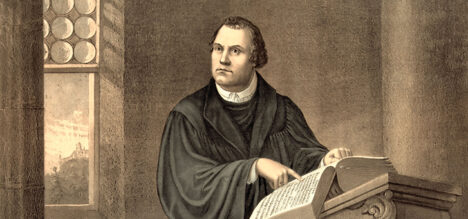
As I trudged up the narrow, winding Alpine trail in northern Italy, the majesty of the mountains, the pure, fresh mountain air, the flower-filled fields and the crystal-clear rushing brooks invigorated my spirits. I paused to take in the awe-inspiring views and my mind drifted back over the centuries. Nearly 600 years ago, a pilgrim band of weary men, women and children fled along this same trail.
The 13th century was not friendly to those who conscientiously opposed the views of the official church. Dissidents were oppressed, persecuted and butchered in the name of religion, but some found refuge in these mountains. I felt an attraction to these godly people of such stalwart conviction. In the face of insurmountable odds they had a death-defying faith.
They had something that the 21st century so desperately needs: a purpose to live for. Renowned American psychologist Philip Cushman, in his book Constructing the Self, Constructing America, discusses people living purposeless lives in a prosperous, self-centred Western individualistic society. He writes about those who have constructed a self that is fundamentally a disappointment to self. They have nothing worth dying for, so they have little worth living for.
But the people whose footprints I followed up the steep, rocky trail had an abiding purpose in life. Their beliefs mattered to them and they were not willing to compromise. In the face of death itself, they had an inner peace. Theirs was a serenity of soul deep within that is absent in our twenty-first-century world of glitz, glamour and immediate self-gratification.
Who were the Waldenses?
As the spiritual darkness in medieval Europe deepened and the established church drifted further away from biblical teachings, false doctrines held minds hostage. The masses were consumed with guilt. They viewed God as a wrathful tyrant and vindictive judge who needed to be appeased rather than a loving God who cared for them and longed for their affection.
At this critical juncture of human history, God began to raise up spiritual seekers who would lead men and women out of spiritual darkness into the light of God’s Word. One of these spiritual seekers was a man named Peter Waldo, who was born in Lyons, France in AD 1140. He was the leader of a group of Bible-believing Christians who became known as the Waldenses. Peter Waldo believed that the Bible was the basis of all faith, the foundation of truth and an infallible guide for all believers. He rejected the notion that the Bible must be interpreted by the church to be understood, and he taught that the average person could read and understand the Bible for themselves.
Rediscovering the Word of God
What we believe about the Bible makes a dramatic difference in how we live our lives. If the Bible is simply a collection of human ideas, we can accept it or reject it with little eternal consequence. But if the Bible is the divinely inspired Word of God, neglecting its teachings has eternal consequences. The Waldenses accepted the the Word of God by faith, but does it stand up to the scrutiny of modern scholarship?
Here is one critical fact: the Bible contains claims that its contents are inspired by God; that the Holy Spirit influenced the dozens of authors who wrote it. It uses expressions like “and God said” or “the Lord spoke” more than 3000 times. The apostle Paul, in writing to his young colleague Timothy, declared, “All Scripture is God-breathed”
(2 Timothy 3:16).
If the Bible is not inspired, there are implications. Either those who claimed to be inspired were deliberately lying, or they were deluded. If either of these alternatives is true, how could the Bible possibly have such power to change millions of lives? How could its moral claims be so eloquently stated? How could its prophecies be so accurate and the archaeological evidence for its truthfulness be so convincing?
Let’s examine some of the evidence.

J Barton Payne’s Encyclopedia of Biblical Prophecy lists 1239 prophecies in the Old Testament and 578 prophecies in the New Testament—a total of 1817 prophecies in the entire Bible. Some 700 years before the birth of Jesus Christ, the prophet Micah predicted He would be born in Bethlehem (Micah 5:2). It’s no accident that a decree of Caesar Augustus brought Mary and Joseph from their hometown of Nazareth to Bethlehem before Jesus’ birth—it was an exact fulfilment of Micah’s prophecy. But the predictions do not end there. Isaiah predicted the Messiah would be born of a virgin (Isaiah 7:14). The psalmist David predicted the Messiah would be crucified (Psalm 22:16). And Zechariah declared He would be betrayed by a friend for 30 pieces of silver (Zechariah 11:12, 13).
Some of the most fascinating prophecies of the Bible deal with nations and entire empires. Jeremiah predicted that the ancient, mighty city of Babylon would be destroyed and never rebuilt: “Babylon will be a heap of ruins, a haunt of jackals, an object of horror and scorn, a place where no one lives” (Jeremiah 51:37). Many cities throughout history have been destroyed by the ravages of war, but most have been rebuilt and are thriving cities today. But not Babylon.
Cyrus, the Persian general who led the attack on Babylon, was named in Bible prophecy nearly 150 years before Babylon’s overthrow (Isaiah 44:28; 45:1, 2). And Alexander the Great’s Greek empire was specifically named by the prophet Daniel as the nation that would overthrow the Medes and Persians (Daniel 8:20, 21) at least 15 years before the event. The windswept sands of time forcefully speak of the accuracy of the Bible’s predictions.
It would take a quantum leap of faith to believe that these predictions were fulfilled by chance. The mathematical possibility that each of these predicted events took place by some random accident is too large to be imagined.
Recent discoveries in archaeology help to verify numerous people and places mentioned in the Bible, giving us another link in the chain of evidence pointing to divine inspiration. For example, the discovery of the Dead Sea Scrolls at Qumran in 1947—ancient documents that match closely with more recent Bible manuscripts—helps to build our confidence that the Bible has been copied accurately through the centuries. The Moabite Stone discovered in 1868 in Jordan confirms the Old Testament story of the Moabite attacks on Israel as recorded in 2 Kings. The Lachish Letters, discovered in 1935, describe the attack of Nebuchadnezzar on Jerusalem in 586 BC. They detail the campaign from the perspective of the ancient pagan forces; biblical history tells the same story from the Israelite point of view. And the discovery of the Tel Dan Stele confirms the Bible’s account of David as the king of Israel.
The Bible mentions a people called the Hittites 48 times, painting the picture of a powerful ancient empire. Yet for centuries, in all the records of antiquity outside of the Bible, not a trace of the Hittites was evident. Many scholars reasoned that the Hittites never existed and the biblical accounts were fable. Then came the discovery of the Rosetta Stone in 1799, which carried an inscription in Greek, Demotic and the mysterious hieroglyphs of ancient Egypt, which, up to that point, no historian had been able to decipher. When the brilliant French scholar Jean-François Champollion, using the Rosetta Stone, finally unlocked the mystery of the ancient picture-writing of the Egyptians, centuries-old monuments now spoke and revealed that the Hittites did in fact exist; that they were the powerful nation the Bible describes, battling against the Egyptians.
Life-transforming power
Millions around the world testify to the changes in their lives as a result of their Bible study. The Bible’s appeal is both universal and eternal. Its message speaks to people of all ages, to all ethnic groups and to all cultures in all generations.

Through reading the Bible, drunkards become sober, thieves become honest, prostitutes become pure and drug addicts become clean. Anger, bitterness and resentment yield to loving forgiveness, mercy and graciousness. Crumbling marriages are restored. Broken relationships are rekindled. Shattered self-esteem is restored. In God’s Word, the weak find strength, the guilty find forgiveness, the discouraged find new joy and the despairing find hope. The same Holy Spirit who inspired the Bible writers inspires those who read it.
An unshakeable faith
Recognising the life-changing power of the Word of God, the Waldenses spent countless hours teaching its principles to their children. When still in their teens, Waldensian young people memorised the Gospels of Matthew and John. They copied their precious manuscripts, hid them in their long flowing robes, left their quiet mountain retreats disguised as merchants or students, and travelled to the great cities and universities of Europe. When they were providentially brought into contact with honest seekers of God and truth, they quietly revealed their secret portions of Scripture.
Trail of tears
As I hiked in the beauty of the mountains over the same trail that the Waldenses used centuries ago, my mind turned to their sufferings and undaunted faith. Yes, there are stories of miraculous escapes, but at other times, Waldenses were imprisoned or even martyred for their faith.
The witness of these faithful martyrs calls us to loyalty. The legacy of their lives speaks to us in this easy-going, compromising age. God is calling this generation to a deeper commitment. He is calling us to an uncompromising faith, to a steadfast loyalty to His Word. If you make this commitment you will discover the peace and purpose of the Waldenses along whatever trail you walk and wherever life takes you on its journey of faith.
This article is adapted, with permission, from Unshakable Faith. To get your free copy, see the ad on this page.









